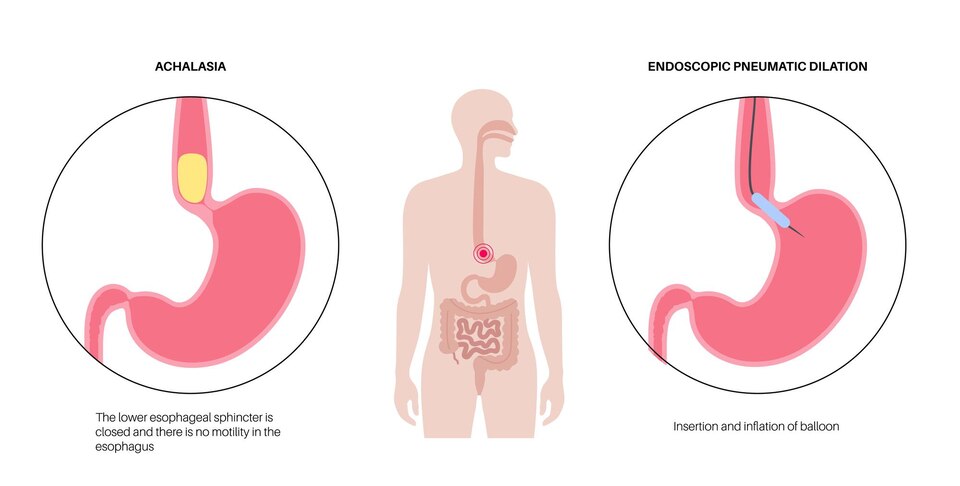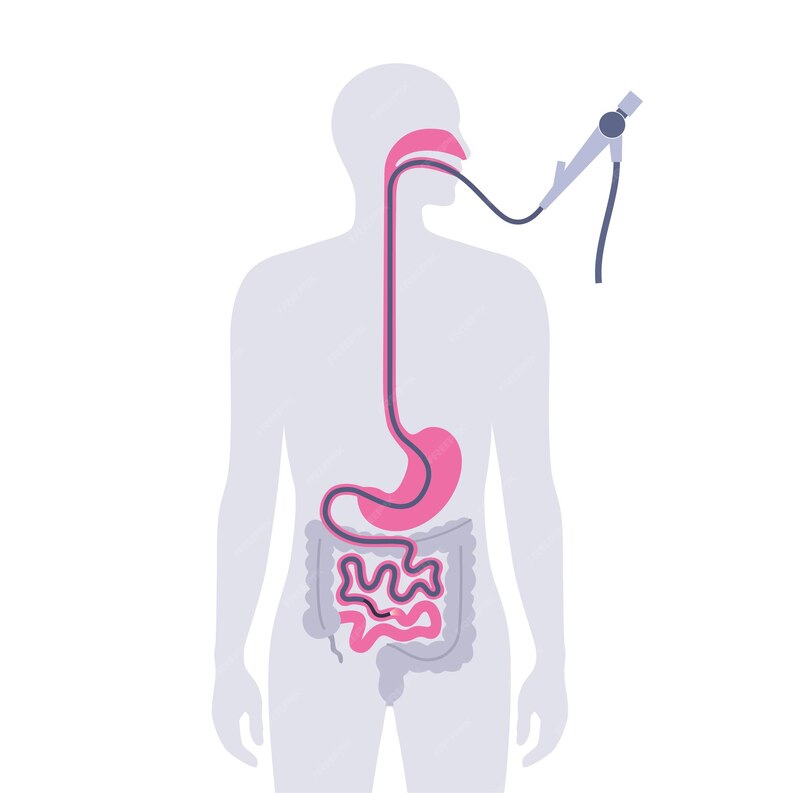Achalasia
Achalasia is an uncommon condition where impaired nerves in the esophagus hinder its normal functioning. The muscles at the bottom of the esophagus don’t properly allow food to pass into the stomach. Signs of achalasia include difficulty swallowing, heartburn, and chest discomfort. Treatment options for this condition involve non-surgical approaches like Botox injections, balloon dilation, and medication, as well as surgical interventions.

What are the symptoms of achalasia?
The symptoms may vary slightly from person to person, gradually appearing as the esophagus loses strength and widens. Some common symptoms may consist of:
- Trouble swallowing food (dysphagia)
- Regurgitation refers to the backward flow of food or liquids into your throat.
- Experiencing an abrupt awakening during the night from coughing or choking caused by the backflow of food or gastric acid
- Heartburn
- Chest pain or pressure
- Trouble burping
- Hiccups
- Weight loss
The signs of achalasia can resemble symptoms of other ailments. It is recommended to consult a healthcare professional for an accurate diagnosis.
Causes
The exact cause of achalasia is unknown to experts, however, there is a belief that it is a result of various factors coming together.

- genetics, or family history
- Achalasia is a medical condition in which the immune system mistakenly targets and damages healthy cells in the body, causing a decline in nerve function in the esophagus. This degeneration is often responsible for the more severe signs and symptoms of the condition.
- injury to the nerves in your esophagus or lower esophageal sphincter
There is a theory suggesting that viral infections may trigger autoimmune reactions, particularly if an individual has a greater genetic susceptibility to the condition.
Achalasia has been connected to Chagas disease, an uncommon parasitic infection that primarily impacts individuals in Mexico, South America, and Central America.
How is achalasia diagnosed?
If you suspect that you could be suffering from achalasia, it is advisable to consult your physician. They might recommend a consultation with a specialized gastroenterologist, who will proceed with various examinations. These examinations may comprise of:
- The procedure called barium swallow involves consuming a solution containing barium, a substance that causes your oesophagus and stomach to be visible when an x-ray is taken.
- Gastrografin swallow: Similar to a barium swallow, you ingest a liquid that will be visible on an x-ray.
- Esophageal manometry involves inserting a slender tube through the mouth or nose to gauge pressure in the esophagus. This procedure helps determine if the muscles or sphincter are functioning correctly.
- Endoscopy involves the insertion of a slender, bendable tube equipped with a light and camera at one end into your mouth. This enables the doctor to inspect the oesophagus thoroughly.
- A chest x-ray can determine if your oesophagus has become bigger in size.
WHAT OPTIONS ARE THERE FOR TREATING ACHALASIA?
There are several ways to treat achalasia, such as taking medication, undergoing endoscopy procedures, or having surgery. Unfortunately, these treatments cannot fully eliminate the root cause of achalasia, but they can greatly alleviate symptoms by relaxing the sphincter and allowing food to enter the stomach. The effectiveness and potential risks of each treatment option depend on various factors.
Hence, it is advisable to have a conversation with your specialist about the most effective way to manage your specific condition and personal situation. This conversation should consider factors such as your age, medical history, time taken to get a diagnosis, and your personal preferences regarding treatment.
Treatments include:
Medicine
Certain medications, like nitrates or nifedipine, have the ability to alleviate tension in the muscles of your oesophagus. As a result, swallowing becomes less arduous and painful for certain individuals, although their effectiveness may vary from person to person.
The impact is only temporary, so medication can be employed to alleviate symptoms as you await a longer-term solution. Although they may lead to headaches, this issue typically gets better with time.
Botox injections
This non-surgical alternative procedure consists of administering Botox injections into your esophagus using an endoscope. If other treatments are ineffective or if you wish to avoid surgery, a healthcare professional may suggest this treatment option.
Botox inhibits the nerves responsible for muscle contractions, which aids in relaxing the LES and facilitating the passage of food. These injections can provide fast relief from symptoms. However, the effects are not long-lasting, necessitating repeat treatments every 6 months to a year.
Some possible drawbacks include the expense of multiple treatments and the potential impact of repeated Botox injections on the overall outcome of future surgeries.
Dilatation
This is the procedure in which a small balloon is inserted through an endoscope while the patient is sedated or under general anesthesia to stretch open the sphincter. When the balloon is in place, it is filled with air to stretch and disrupt the fibers in the sphincter. This treatment alleviates symptoms for approximately 60% of patients, although multiple procedures may be required in some cases. There are potential risks, such as perforation, which the doctor will discuss beforehand.
Laparoscopic Heller myotomy

In this type of surgery that requires minimal invasion, a small incision is made to insert a thin instrument called an endoscope. The endoscope is linked to a small video camera, even smaller than a dime, which displays a view of the surgical site on video monitors in the operating room. During the procedure, the LES muscle fibers are precisely severed. To avoid gastroesophageal reflux, a common side effect of the Heller myotomy procedure, a partial fundoplication is also performed.
POEM, also known as peroral endoscopic myotomy, offers a less invasive option compared to laparoscopic Heller myotomy. In POEM, a knife is used to cut the muscles on the side of the esophagus, the lower esophageal sphincter (LES), and the upper section of the stomach. This cutting action helps to relax the muscles, enabling the esophagus to function properly by efficiently delivering food into the stomach.
Living with achalasia
Achalasia is a long-term health issue, but it can be controlled by collaborating with your medical professional to develop a treatment strategy. Your medical team will require regular check-ups, usually once or twice a year, even if your symptoms have improved. You might also need to undergo additional examinations such as endoscopy and esophagram procedures.
If you are experiencing signs of dysphagia or regurgitation:
- Stop smoking.
- Avoid consuming foods or beverages that can cause heartburn.
- Stay hydrated by consuming a sufficient amount of liquids while eating. Take your time to thoroughly chew your food.
- Eat smaller meals more often.
- Don’t overeat late at night.
- If you experience symptoms during the nighttime, elevate the head of your bed.
post-treatment follow-up
Regardless of the type of treatment you receive, it is important to undergo long-term monitoring. This is because the treatments only provide temporary relief for the symptoms of achalasia and do not cure the condition or halt its progression. There is a possibility that symptoms may return, so your healthcare provider will want to ensure that your esophagus is functioning properly and check for any signs of gastroesophageal reflux that may require treatment. Additionally, your doctor will monitor you to ensure that cancer has not developed.
Treatment in Türkiye:
The medical staff of surgical teams, doctors, and consultants at REHABTÜRK can provide the best treatment options and free consultations, striving to stay up-to-date on the latest medical technologies and methods.
